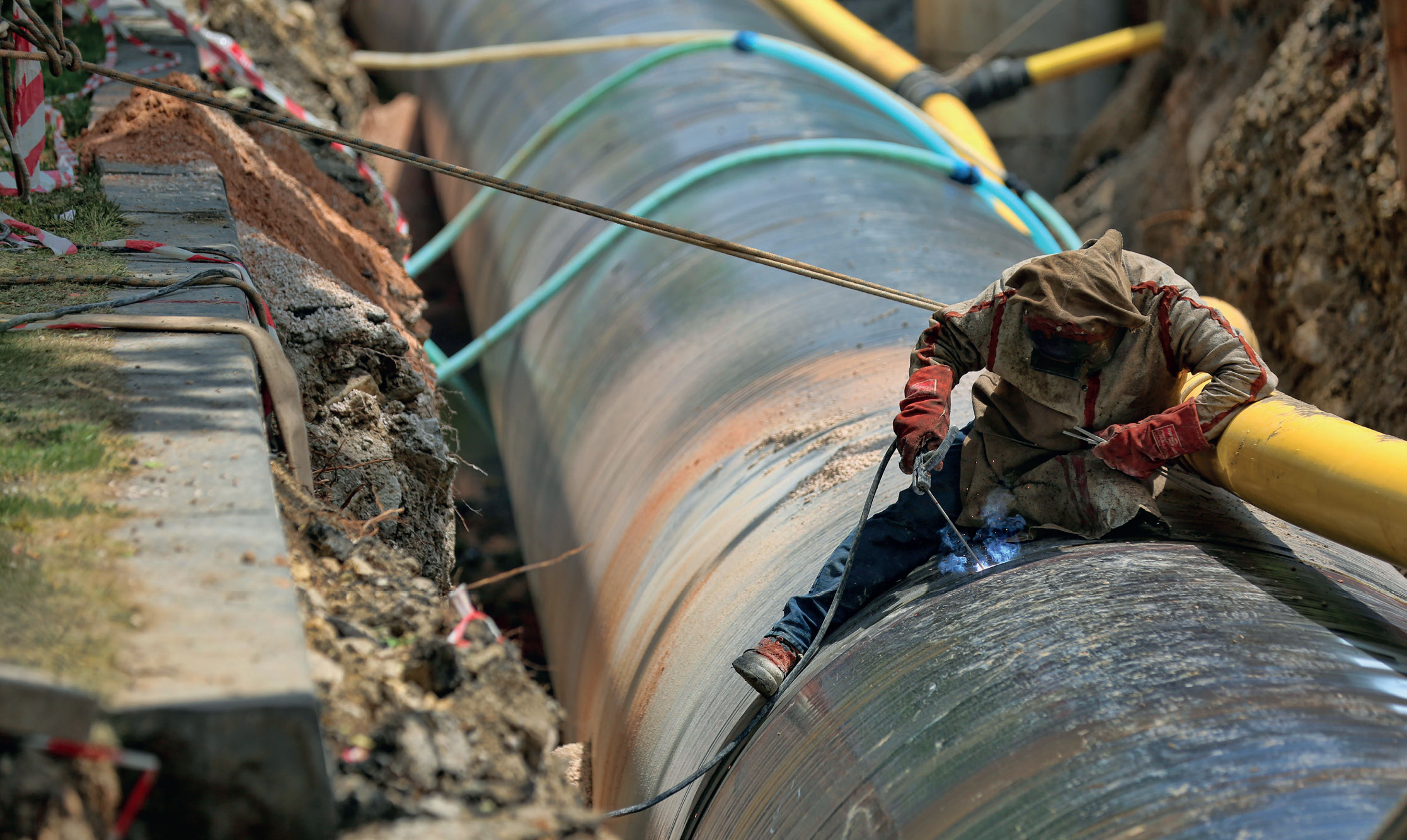The use of valves in pipeline applications is one which is often overlooked, yet they play a crucial role in the functionality of the pipeline. Alongside valves, are the engineers who ensure that said valves are working to the best of their ability.
Valve World Americas had the pleasure of interviewing Sam Fuqua, Senior Market Analyst at Plains All American, to discuss his previous role as an integrity engineer, the use of valves in pipelines, the valve market, as well as providing advice for up-and-coming engineers.
By Angelica Pajkovic
At the age of 26, Fuqua began making a name for himself as an integrity pipeline engineer. He got his start following high school graduation. He was approached by a family friend who worked for a pipeline vendor doing external corrosion work. Fuqua began working in close interval survey (CIS) which means he was responsible for taking voltage readings throughout the pipeline to ensure that the cathodic protection systems were operating at NACE SP0169 specified standards.¹
Following his summer working with pipelines, Fuqua attended Texas A&M University where he majored in Petroleum Engineering and minored in Computer Science. Upon graduating, Fuqua was offered a position at Corrpro, where he designed cathodic protection systems. He also spent time working in the field providing required inspections and maintenance.
After a year at Corrpro, Fuqua took a job as an Integrity Pipeline Engineer with Plains All American Pipeline’s risk team. Today, Fuqua is currently pursuing a master’s degree in Business Analytics with a focus on machine learning and data management. Fuqua intends on applying this knowledge to his role through predictive modelling and improving data management systems.
“When I first get into the office, I check my emails to make sure I did not miss anything from others in offices with time differences,” began Fuqua. “I then have what I like to call ‘focus time’ where I go into a meeting room and plan the day’s tasks. Following that, I see which projects need data, how I can provide the necessary data, and how to provide it in a proper manner. This could be through a document or an automated service that provides the results onto the database with updated information nightly.”
The Role of an Integrity Pipeline Engineer
Fuqua’s work is focuses on data management where he observes and reports the data, and finally, relays it to other teams. His contacts in the field provide more information to complete the most accurate depiction of the pipeline’s current status.
Due to Fuqua diligence working with data management, it is important for him to stay up-to-date with preventative and mitigative (P&M) procedures. “This process consists of looking at the data of the pipeline and making educated judgements, within the regulatory guidance, on when the next assessment should occur and what repairs should take place,” said Fuqua.
P&M procedures are incredibly data intensive, which is why Fuqua influences the way in which data is collected and anticipates even more process adjustments over the next few years
Fuqua’s vision of data analytics is to design a process where they can create BI (business intelligence) reports in conjunction with database management to immediately provide updated information, instead of having to go through the lengthy process of querying data from unrelated data sources. The system would provide the closest version of real-time data management which ensures accuracy both in the office and field. This system would not only help existing employees, but new engineers and analysts get up to speed on their assets. Relaying the data in this way would provide a concise way for the pipeline’s information to be accessed.
Aside from collecting data, assessing the condition of a pipeline is also a large part of an engineer’s analysis. Observing cracks, corrosion and wear, through data, aids in predicting an accurate timeline when a pipeline may begin to falter, enabling the company to implement corrective and mitigative measures. Providing more time for analysis, and follow-up conversations is key, he said.
Pros, Cons, and Challenges in Integrity Engineering
“There are times when there are no clear-cut solutions, so I have to go through thousands of lines of data points line by line. That gets to be tedious,” chuckled Fuqua. Aside from going through the thousands of lines of data, there may be database management issues, meaning there are hardware limitations that integrity engineers must abide by. “I have to make do with what I have. I cannot use 10 million points, even though I may want to, so I must bring that down to maybe 10,000 while still providing as much detail as possible.”
Another challenge, Fuqua added, is explaining and showing new methods of technology to the older generation of engineers.
“There is almost always going to be pushback from older generations when it comes to new technology,” stated Fuqua. “The more established engineers know that the methods they have used for decades work, so encouraging them to learn and utilize new forms of inputting data is not always a simple task.”
In a method Fuqua called “future proofing”, he noted the importance of guiding companies to new and easier ways of performing tasks, which he hopes to help develop.

Valves in Pipelines
“In the real world, a pipeline has a valve from beginning to end.” Fuqua works with GIS (geographic information system), a computer system for capturing, storing, checking, and displaying data related to positions on Earth’s surface², and due to the limitations of that system, a valve on two pipeline segments can only be modeled on one segment at a time.
“Generally, we define the beginning of a pipeline segment as the valve at the upstream pig trap and the ending as the valve at the downstream pig trap. However, occasionally the pig trap at the end of a segment is the same trap that is at the beginning of an adjacent segment. In cases like this, the valve can only be modeled on one segment even though they share the same valve. This does not affect any kind of analysis, but it is a current digital limitation in the industry.”
A pipeline ‘pig trap’ refers to the vessels used for launching a ‘pig tool’ into the pipeline for cleaning or inspection purposes. ³
The main objective when performing a high consequence analysis (HCA) is to determine where oil may spread if an incident occurs. Other than determining the potential spread in intervals along the pipeline, valves are chosen as a potential release point due to their nature of being constructed of many parts. HCA is largely driven by valve location and shutoff time which can reduce the total volume released from a pipeline during an incident. Thus, the outcome of this analysis is critical to ensuring the valve is performing to the best of its abilities.
Automated shut-off valves are also convenient since they use a new technology allowing them to sense when an abnormality, has occurred. They post new information in the database to be relayed to an analyst. The inclusion of this technology has aided control room operators as they are informed by the database of an abnormality within two to three minutes of it occurring.

Valve Market Supply and Industry Developments
Unlike many other industries at this moment, the valve market is not suffering from shortages, according to Fuqua. At Plains All American, the Joint Venture between Plains and Oryx has helped diversify the company. “We saw a way of improving our efficiency and having more pipeline connections where they matter most,” said Fuqua. “I see us as trying to help with the supply chain by providing energy, rather than be effected by it.”
On the topic of industry developments and where Fuqua sees the future of valves heading, he mentions renewables. “Renewables will cause different types of complexities in the industry,” stated Fuqua. While there are bound to be bumps in the road with learning new methods, Fuqua sounded hopeful stating, “I think it is an exciting time for new engineers.”
Advice to Newcomers
While Fuqua is still emerging in his career, he provided advice he has since learned through experience in both the office and field. “The end user does not need to understand how the result was achieved. They need to know if it is fast, if it gives them the results they want, and, to an extent, if it is visually pleasing.”
”With my recent career change into our marketing department, I plan on utilizing similar data integration techniques to improve data analysis in a different area of the company and industry as a whole,” Fuqua said when asked about his plans with Plains. “It is an exciting time in my career as I will learn the skills to not only lead Engineering through a digital transformation, but the midstream industry as a whole.” The desire to lead is one trait that every new engineer should want to develop, Fuqua recommends. “Being a leader on your team, from techs in the field to engineers in the office, is the best way to provide value for your company,” he concluded.
REFERENCES
- https://www.matcor.com/services/close-interval-surveys-cis/
- https://education.nationalgeographic.org/resource/ geographic-information-system-gis
- https://www.enggcyclopedia.com/2011/07/pig-traps-pig-receivers-pig-launchers/weather%20and%20 improved%20reporting.


